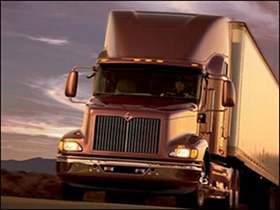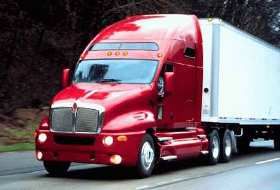Rough Day And Rude Truckers
Topic 16623 | Page 2

I always wait until I'm straight and in the a slot before sliding tandems back unless they require it at the gate.
For example; I'm at a delivery where we are required to disconnect and pull forward during the unload. So space to maneuver is even less than normal. Easier to have tandems forward. And I'll slide em forward before pulling out.
Tandems:
Tandem Axles
A set of axles spaced close together, legally defined as more than 40 and less than 96 inches apart by the USDOT. Drivers tend to refer to the tandem axles on their trailer as just "tandems". You might hear a driver say, "I'm 400 pounds overweight on my tandems", referring to his trailer tandems, not his tractor tandems. Tractor tandems are generally just referred to as "drives" which is short for "drive axles".
Tandem:
Tandem Axles
A set of axles spaced close together, legally defined as more than 40 and less than 96 inches apart by the USDOT. Drivers tend to refer to the tandem axles on their trailer as just "tandems". You might hear a driver say, "I'm 400 pounds overweight on my tandems", referring to his trailer tandems, not his tractor tandems. Tractor tandems are generally just referred to as "drives" which is short for "drive axles".
The nice thing about backing with the tandems back is that you don't have to worry about tail swing. But it takes more room to set up properly. It doesn't always require more room in front of the spot though--that depends on the situation.
The nice thing about backing with the tandems forward is that it's alot easier to set up. You can position those tandems exactly where you want them without having to drive all over the place. But tail swing can end you if you're not careful. Backing with tandems forward is great if there's no one on your blind side. But if you're backing between two semi's and you're really nervous about tail swing, just move the tandems back. In that particular situation, you will use about the same amount of space in front of the spot whether the tandems are forward or back.
I think the best thing is to find what YOU are most comfortable with. I used to leave my tandems forward for tight backs since that's what my trainer taught me...until I almost hit another truck with my tail swing in a truckstop. After that I started sliding them all the way back for tight spots. Now, I prefer to have my tandems somewhere around the 40' mark most of the time--overall a pretty good balance for driving and backing--but I'm pretty comfortable backing no matter where they are at this point.
Tandems:
Tandem Axles
A set of axles spaced close together, legally defined as more than 40 and less than 96 inches apart by the USDOT. Drivers tend to refer to the tandem axles on their trailer as just "tandems". You might hear a driver say, "I'm 400 pounds overweight on my tandems", referring to his trailer tandems, not his tractor tandems. Tractor tandems are generally just referred to as "drives" which is short for "drive axles".
Tandem:
Tandem Axles
A set of axles spaced close together, legally defined as more than 40 and less than 96 inches apart by the USDOT. Drivers tend to refer to the tandem axles on their trailer as just "tandems". You might hear a driver say, "I'm 400 pounds overweight on my tandems", referring to his trailer tandems, not his tractor tandems. Tractor tandems are generally just referred to as "drives" which is short for "drive axles".
HOS:
Hours Of Service
HOS refers to the logbook hours of service regulations.
You got it in there and you didn't hit anything.
Besides the fact that that guy was a total ass, circling the building to retry is not a bad idea. I think the setup is much more important than where your tandems are.
Last week i was at a shipper and i was in dock 2. They come out and tell me to move to dock 3. What did i do? I pulled the truck forward a little and tried to jam the truck into the dock next to it. It was a nightmare. I should have circled the building and reset. Would have saved a ton of time and embarrassment.
Safe travels.
Shipper:
The customer who is shipping the freight. This is where the driver will pick up a load and then deliver it to the receiver or consignee.
Tandems:
Tandem Axles
A set of axles spaced close together, legally defined as more than 40 and less than 96 inches apart by the USDOT. Drivers tend to refer to the tandem axles on their trailer as just "tandems". You might hear a driver say, "I'm 400 pounds overweight on my tandems", referring to his trailer tandems, not his tractor tandems. Tractor tandems are generally just referred to as "drives" which is short for "drive axles".
Tandem:
Tandem Axles
A set of axles spaced close together, legally defined as more than 40 and less than 96 inches apart by the USDOT. Drivers tend to refer to the tandem axles on their trailer as just "tandems". You might hear a driver say, "I'm 400 pounds overweight on my tandems", referring to his trailer tandems, not his tractor tandems. Tractor tandems are generally just referred to as "drives" which is short for "drive axles".
New Reply:
New! Check out our help videos for a better understanding of our forum features

















Preview:








 TT On Facebook
TT On Facebook